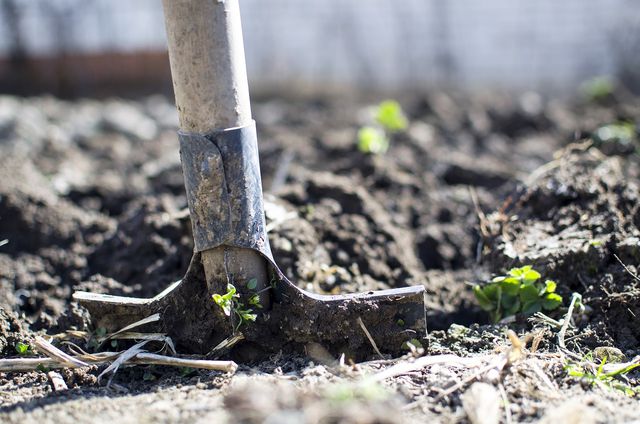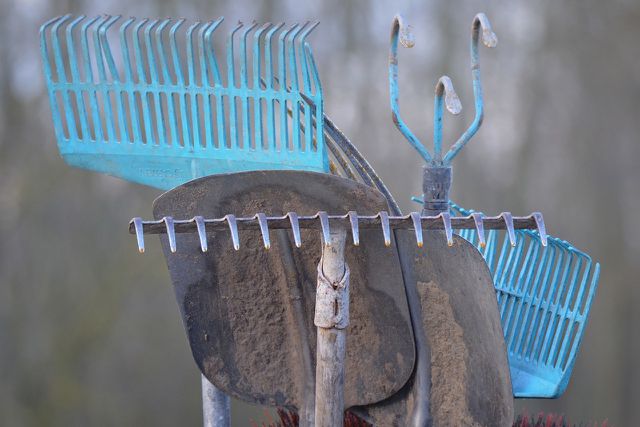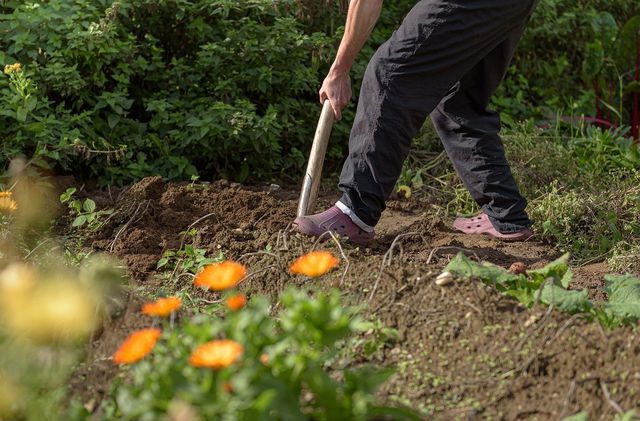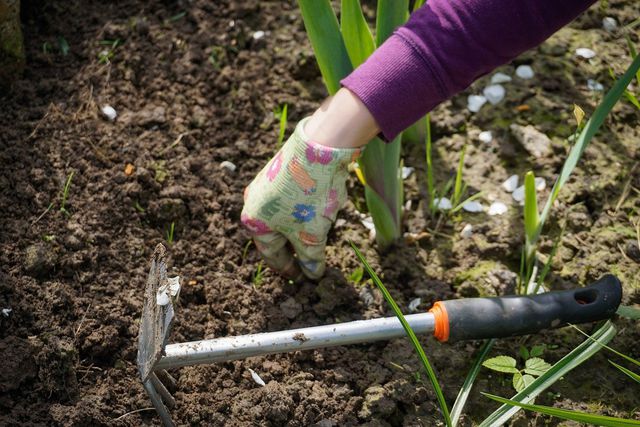If you want to dig up the garden, the main thing to wait for the right time. Especially for a vegetable garden is important to dig up the garden again and again, so that the plants grow well.
For amateur gardeners, digging up the vegetable beds is an important preparation for sowing. The gardener loosens the top layer of soil and at the same time transports plant residues and weeds into deeper layers of soil. This raises not only the question of the right time and the appropriate equipment, but also whether digging over makes sense at all.
In this garden guide, you’ll learn everything you need to know about digging up.
Contents
- 1 Digging up the garden: The best time
- 2 What is in favor of digging up the garden in the fall:
- 3 Against garden digging in the fall:
- 4 Digging garden in the spring:
- 5 In favor of digging garden in the spring:
- 6 Digging up garden: Tools for digging
- 7 You should pay attention to this when buying garden tools:
- 8 How to do: properly dig up the garden
- 9 Alternatives to digging up the garden
- 10 mulching
- 11 green manure
- 12 Author
Digging up the garden: The best time

The best time to dig up is in autumn and spring. We show you what speaks for it and what speaks against it
What is in favor of digging up the garden in the fall:
The dug-up soil lies on the surface in winter. The frost causes the clods of soil to break up. This promotes a fine-grained soil and makes it easier to work in the bed later.
In the sunny, weather-stable fall, the soil is loose and not as heavy from wetness as it is in the spring.
You only need to loosen the soil a little in spring before sowing. There is no need for the long wait before planting.
Against garden digging in the fall:
Digging up the beds changes the micro-organism structure. Soil organisms that do not survive the winter frost come to the surface. This changes the metabolic processes in the soil.
A good time to do this is in the fall, after the last harvest of vegetables. You should definitely dig up the soil before the first ground frost. The period from mid-September to the end of October is best.
Digging garden in the spring:
In favor of digging garden in the spring:
The soil structure is preserved during the winter. This protects the living organisms in the soil from frost.
The nutrients contained in deeper layers of soil are protected. Rain and snow cannot wash out the food for the plants.
Against digging garden in the spring speaks:
You depend on the duration of winter: If there is a long permafrost in the ground, you can dig up the soil only very late in the spring.
The soil can be very wet and heavy after the snow melts. Digging over in the spring is usually much more strenuous than in the fall.
Wet-heavy soil breaks down into coarse clods and requires extra effort to create a fine-crumb structure.
Microorganisms must break down the fresh compost incorporated during digging before you can seed and plant.
To allow the soil to settle, you’ll need to wait a few weeks before using the vegetable bed.
For spring work, wait for the ground frost to end. It is important to till the soil as early as possible so that it has enough time to settle again. The period from mid-February to the end of March is best.
Digging up garden: Tools for digging

To save the arms and back, it is important to choose the right gardening tools. Only a few tools are necessary. More important than many different garden tools, is the quality of the tool for digging.
You should pay attention to this when buying garden tools:
Even if it is tempting – avoid combination tools with one handle and several attachments. The plug connection is usually made of plastic and therefore a possible breaking point.
Tools made of plastic are not only bad for the environment because of the material used, but also break more easily. So better a good tool than new ones made of plastic over and over again.
Garden tools should withstand a lot of weight and pressure. Therefore, use tools made of sturdy stainless metal or thick wood.
When buying garden tools, look for durability.
Don’t just choose the tool with your eye, touch it. Try it out to see how it feels in your hand and if it fits your body.
Buy your garden tools at a specialty store and get advice from a professional.
If you are taking over someone’s garden, you may be able to purchase the tried-and-true second-hand tools from the previous owner.
These tools are helpful when digging around garden beds:
- Spade for digging around and turning the soil.
- Spading fork, soil claw, or cultivator for loosening clods of soil.
- Cultivator or double hoe for removing weeds.
- Rake or rake for smoothing the soil.
How to do: properly dig up the garden

Almost every gardener has its own methods and tricks, how best to dig up the garden. Basically, it’s just a matter of turning the soil and breaking up the clods.
This way, you’ll dig up the garden bed extra easily:
- First, remove larger weed plants with a cultivator.
- Start on one side of the bed and dig into the soil with the spade.
- Step on the edge of the spade with your foot to make your work easier.
- Lift the soil up with the spade, turn the spade and drop the soil upside down into the hole with momentum.
- The clod of soil should break in the process. If necessary, assist with the spade to crumble the soil.
- Repeat the process until you have tilled over the entire bed.
- Loosen the remaining clods of soil with the soil claw or a cultivator.
- Then smooth the surface with a rake.
Tip: If you want to work compost into the soil at the same time, sprinkle the garden bed with the required amount of compost before tilling. Work the compost into the soil while tilling.
This is how you systematically weed the garden bed:
- First remove larger weed plants with a cultivator.
- Start on one side of the bed and dig a small trench along the entire length with a spade.
- Fill the excavated soil into a wheelbarrow.
- Now dig the next row along the excavated trench.
- Fill the first trench with the newly excavated soil.
- Repeat the process until you reach the end of the bed.
- Fill the last trench with soil from the wheelbarrow.
- Loosen the remaining clods of soil with the soil claw or a cultivator.
- Then smooth the surface with a rake.
Alternatives to digging up the garden

When digging, you turn the top layer of soil and move plant residues and weeds into deeper layers of soil. Billions of different microorganisms live in the soil. Most of them are invisible to the naked eye. Many of the soil organisms depend on an individual living condition, which they only find in a certain soil depth. If you upset the soil structure when digging, many of these organisms will die due to lack of oxygen or drought. This can temporarily halt some metabolic processes that are important for plant growth. Until the soil life recovers, plants may not be able to absorb enough nutrients from the soil.
There are good alternatives to digging over that nature-oriented gardeners like to use:
mulching
Instead of digging up the garden, cover the harvested vegetable bed in late summer or fall with a mulch layer of fall leaves, semi-mature compost and crop residue.
The mulch protects the soil from:
severe temperature fluctuations
silting
a lot of weeds
green manure
Alternatively, you can sow green manure, such as phacelia or yellow mustard.
Mow down the green manure plants before the seed matures.
Leave the mown plant parts as a mulch layer until spring.
This is how you prepare the vegetable bed for seeding in the spring:
- Remove the mulch layer with a rake.
- Work the soil with a so-called sow’s tooth, a cultivator or a soil claw.
- Loosen the soil deeply with one of the three tools without turning it.
- Remove weeds and other plant debris from the soil with a cultivator or rake.
- Work some mature compost into the soil.
- Wait about two weeks before sowing to allow the soil to settle again.
- Loosen the soil with a rake before adding seeds to your bed or planting plants.

